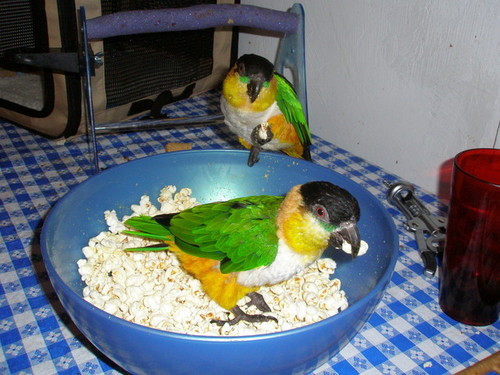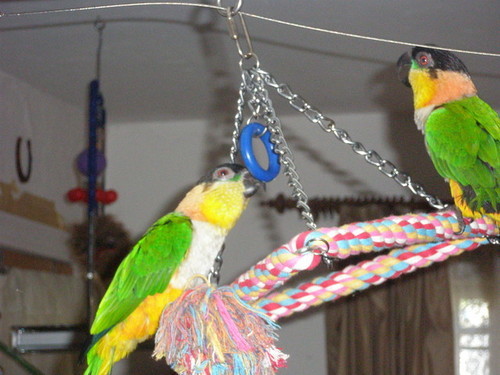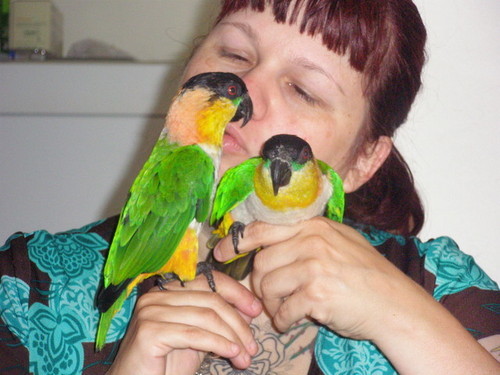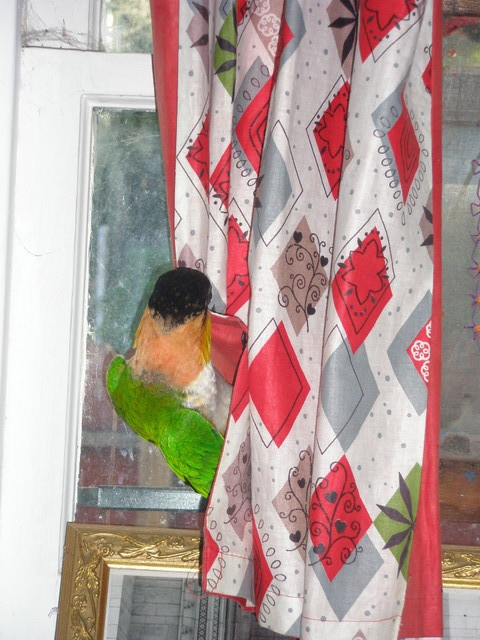Not that we don’t love all parrots, after all- they are all amazing. But I have a soft gushy place in my heart for Caiques. I have two Caiques, named Tengu and Tallulah (aka “Goo and Loo” or “T and T (dyno-mite!)”).

Loo is daintily perched on the rim, while Goo is full on IN the popcorn.
Caiques (pronounced “ky-eeks”) are two species of small, brightly colored parrot in the genus “Pionites”.
Origin:
They originate from the area of the Amazon Rainforest of northern Brazil and southern Venezuela, and the Guiana highlands. The Black-Headed Caique (Pionites melanocephala- like Goo and Loo), originates from North of the Amazon and westward to parts of Venezuela, Ecuador and Peru. The White-Bellied Caique's (Pionites leucogaster) habitat is South of the Amazon, from northern Brazil and spreading to parts of Bolivia, Ecuador and Peru.
Appearance:
The Black-Headed Caique (BHC) is slightly smaller than the White-Bellied Caique (WBC), with mature lengths of 23-25cm and weights of approximately 150g and 170g respectively. Caiques are also occasionally known as the “Seven Color Parrot” because of their many feather colors. (Black, Green, Yellow, Orange, White and Blue hued feathers have all been observed.)
White Bellied Caiques (WBC):
All WBC are Pionites leucogaster. From there they are broken down into three subspecies.
WBC, Green-thighed: Pionites leucogaster leucogaster.
WBC, Yellow-thighed: Pionites leucogaster xanthomeria.
WBC, Yellow-tailed: Pionites leucogaster xanthurus.
Black Headed Caique (BHC):
Both Black-headed caiques are Pionites melanocephala. From there they are broken down into two subspecies.
Black-headed (the BHC we have in the U.S.): melanocephala with the full scientific name being Pionites melanocephala melanocephala.
Pallid: pallida with the full scientific name being Pionites melanocephala pallida.
Personality:
If you want a bird that will sit contentedly on a perch, then a Caique is not for you. No matter how may toys you have on or near the perch, there are other, more exciting things to explore. This wonderful little bird that is known as ‘the clown of the parrot world’. They are stubborn, fearless, good with strange situations, acrobatic, affectionate, and have a great sense of humor.

Swinging and screaming, two things at which Caiques excel.
While most sites will tell you that there is little difference in personality between the two species, I have observed that WBCs are a bit more mellow than their BHC counterparts. This is anecdotal of course, but it is a belief based on observation of dozens of each subspecies. Which to choose is often decided by price and availability- as they are rarer than other parrots to obtain. Typically WBC are more expensive than the BHC, because the latter is more common. Prices can range from $600 to $1500, depending on source and area of the country so it is best to shop around. Pet stores usually are on the high end of the price scale.
Diet:
In the wild, Caiques generally prefer forested areas as habitat and subsist on fruit and seeds. They have no special dietary requirements; pellets supplemented with fruits, vegetables and other foods common to parrots will satisfy their needs and requirements. Some breeders are known to supplement their diet with lory nectar. They do have a fondness for chewing natural green branches, so providing a supply of these is recommended.
My birds LOVE Momma's Birdie Bread. I make it in mini muffins and freeze them, so that they have a steady supply. Their favorite flavor is Harvest Loaf, followed by Caribbean Loaf. But they have had every flavor and eat the muffins enthusiastically!
Care:
They aren’t very big birds, but they will use every square inch of their cage, so that I would recommend no smaller than a 24 x 24 x 18 inch cage- and that is a bit on the small side. My girls share a 36” x 25”. Be sure barspacing is no wider than 5/8”.
They play rough, and will play with toys that most people would reserve for larger birds such as Amazons. They are not afraid of anything, and during their time out of the cage, they should be watched closely so they don’t get themselves in trouble. Because they do love trouble- many people name their Caiques accordingly- I have met Caiques named Loki, Bandit, Outlaw, and of course, Tengu!
Behavior/Quirks:
They can be headstrong, so consistent discipline is a must from the start. Decide what is and is not acceptable behavior, and stick to it. They tend to use their beaks on fingers as well as toys. It is not meanness, but just excess energy and curiosity. To discourage beaking of your body parts, keep some toys handy and substitute the toy for your fingers. If the bird insists on chewing on you rather than a toy, some cage time may be appropriate (a “time out”).
They are also rather food aggressive, and if you train them that you should be able to touch them while eating from the beginning, it will serve you well in time.

Tengu, loving on mama and Talullah, gunning for the camera. She wants to eat it one day.
Other behavior issues may include screaming for attention. This may happen in the morning when they are waiting for food (one of a Caique’s favorite things- they eat and play constantly) or when their favorite person leaves the room. The good news is that a Caique does not approach near the volume of larger parrots such as Cockatoos and Macaws. And they don’t actually “scream” as much as beep and whistle- but it is shrill.
This call is s a high pitched, single note call which they repeat at intervals. It does drive some people crazy. Caiques can learn to talk, so if you can teach your bird to “call” you with words rather than yells, so much the better. Caiques are highly intelligent and will soon figure out what you approve and disapprove of if you are consistent in your reactions. Please note: not all Caiques talk well, and if that is important to you, another species is a better choice.
While playing with their favorite human, they may engage in an activity known as “hair surfing”. To do this, they grab a footful of hair and begin swinging back and forth and rubbing their breast on the hair and head of the chosen person. No one knows quite why they do this (many have speculated that it is displaced leaf bathing behavior, as they tend to do it most often after bathing), but they love it, and the only possible problem with it is that they could become a bit tangled up, so be careful of this. You haven’t lived until you’ve had four baby Caiques all hair surfing on you at the same time.
Sally Blanchard, parrot behaviorist, talks about Spikey Le Bec, her famous Caique: “Spike is also clever — very clever. Sometimes too clever for me. If there is mischief, he will find it. If there is a way out of his cage, no matter how hard he has to work, he will find his way out. He is not the type of bird who can be trusted to stay alive out of his cage without close supervision. He has learned several tricks in less time than it takes me to think of them. …About the hair-surfing thing, this IS his obsession. …The record (is) 45 minutes although a few (other) people (have) come close….
Spike is exceptional in crowds of people. He is fearless (except for balloons which terrify him!) and will generally go to and be delightfully tame to almost anyone. Sometimes it even surprises me because he can be a real butt around his cage at home — especially if he is involved with a favorite food. Spike and the other Caiques I know are real gluttons when it comes to food. They love to eat almost anything and become very possessive about their favorite foods. Like most narcissists, Spike is not into sharing. I think the only food he has ever rejected was a small piece of smoked oyster. Since that shouldn’t be a part of his diet, it didn’t matter anyway….Would I recommend a Caique as a pet for everyone? — Absolutely not! Would I recommend one to a knowledgeable bird owner willing and able to do “the right thing” for their avian companion — absolutely!”

Talullah, climbing the curtains.
Further Resources:
Slideshow of caique egg to adult
Companion Parrot Online (home to Sally Blanchard and Spikey LeBec)
Now through 10/4, use the code ilovecaiques to get 20% off your order over $75!
Slideshow of caique egg to adult
Companion Parrot Online (home to Sally Blanchard and Spikey LeBec)
Now through 10/4, use the code ilovecaiques to get 20% off your order over $75!

No comments:
Post a Comment